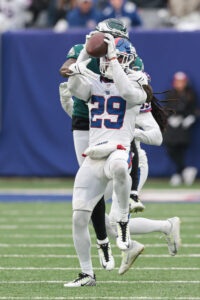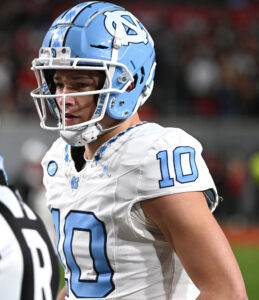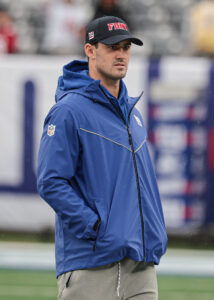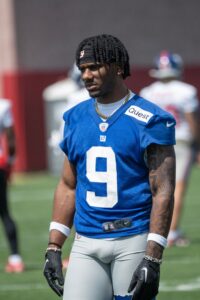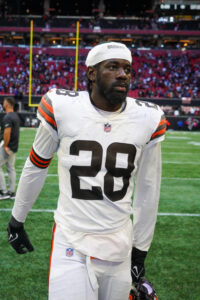The 2023 Giants offseason brought significant investments from the Joe Schoen regime in Dave Gettleman-era acquisitions. One of those moves has come to define Schoen’s regime. The team’s decision to give Daniel Jones a four-year, $160MM deal with two fully guaranteed seasons, while franchise-tagging Saquon Barkley, ended one long-running partnership and has another on shaky ground. Months after Jones’ ACL tear wrapped a woeful season from the now-well-paid quarterback, Barkley signed with the Eagles.
Following a surprise playoff showing in the Schoen-Brian Daboll partnership’s first season, the Giants tumbled off that tier in 2023. Jones is back in “prove it” territory, while Daboll — his 2022 Coach of the Year accolade notwithstanding — may join his QB in a make-or-break year. This Giants offseason involved key decisions, though it largely boiled down to one call in late April.
Trades:
- Sent Nos. 39, 141, 2025 fifth-rounder to Panthers for OLB Brian Burns, No. 166
The Giants look to have benefited from both the Panthers’ regime change and the fallout from the now-infamous rejected Rams trade proposal at the 2022 deadline. It took only a package headlined by a second-round pick for the Giants to pry Burns from the Panthers, who had franchise-tagged the disgruntled edge rusher. Burns, 26, will now team with Kayvon Thibodeaux to give the Giants their best-looking OLB duo since at least Jason Pierre-Paul and Olivier Vernon.
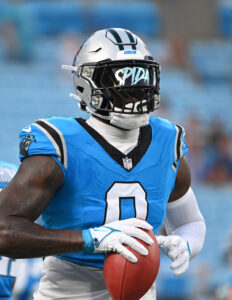 A complex route formed to deliver Burns to New York; a fork in that road emerged in October 2022. As the Panthers regrouped following Matt Rhule‘s firing, they dealt Christian McCaffrey to the 49ers for four picks. None of those was a first-rounder. Other Carolina cogs drew extensive interest, with Burns at the front of that pack. Shortly after the Rams missed out on McCaffrey, the team — at the end of its “eff them picks” period — attempted to add a reinforcement to a sinking Super Bowl title defense by offering two first-rounders and a third for Burns.
A complex route formed to deliver Burns to New York; a fork in that road emerged in October 2022. As the Panthers regrouped following Matt Rhule‘s firing, they dealt Christian McCaffrey to the 49ers for four picks. None of those was a first-rounder. Other Carolina cogs drew extensive interest, with Burns at the front of that pack. Shortly after the Rams missed out on McCaffrey, the team — at the end of its “eff them picks” period — attempted to add a reinforcement to a sinking Super Bowl title defense by offering two first-rounders and a third for Burns.
Still owing the Lions their 2023 first-rounder from the Matthew Stafford trade, the Rams could not offer their 2023 first. That turned out to matter, as then-GM Scott Fitterer — whose job security was unstable after David Tepper axed Rhule — viewed the opportunity to discuss an extension with Burns as more valuable than 2024 and ’25 firsts. Denying Burns a chance to land in Los Angeles with a likely extension awaiting reframed the Panthers’ re-up talks with their top pass rusher.
Irked at Carolina turning down a big trade offer that doubled as a path for an L.A. extension, Burns did not come to terms with the team that drafted him. As Burns’ asking price soared, Fitterer balked at extending him in 2023. After Fitterer’s firing, the Panthers took what they could get — after pausing extension talks in early March — and finally cut bait.
Burns and the Panthers were not believed to be close on terms, as the five-year veteran pushed for a deal in the $30MM-per-year range before Nick Bosa became the NFL’s first $30MM-AAV edge rusher. Burns asking for terms bettering T.J. Watt‘s Steelers extension understandably spooked the Panthers, who did receive trade offers for the Ron Rivera-era draftee at last year’s deadline. Of course, those proposals are not believed to have come in near where the Rams went.
 The Giants gave Burns a five-year, $141MM extension upon completing the trade. Not seeing Azeez Ojulari deliver consistency alongside Thibodeaux, the Giants greenlit a big-ticket deal that should pair well — for the time being, at least — with their top-10 pick’s rookie contract. Although the Jaguars’ Josh Allen passed Burns this spring, the new Giants OLB still ranks third among edges in AAV ($28.2MM) and fourth in total guarantees ($87.5MM) and fully guaranteed money ($76MM). Much will be expected from a player who has proven reliable while settling in outside the top tier, production-wise, at his position.
The Giants gave Burns a five-year, $141MM extension upon completing the trade. Not seeing Azeez Ojulari deliver consistency alongside Thibodeaux, the Giants greenlit a big-ticket deal that should pair well — for the time being, at least — with their top-10 pick’s rookie contract. Although the Jaguars’ Josh Allen passed Burns this spring, the new Giants OLB still ranks third among edges in AAV ($28.2MM) and fourth in total guarantees ($87.5MM) and fully guaranteed money ($76MM). Much will be expected from a player who has proven reliable while settling in outside the top tier, production-wise, at his position.
While Jones’ AAV checks in beyond Burns’, the latter received the most guaranteed money in Giants history. Burns is 1-for-5 in 10-plus-sack seasons, totaling 12.5 in 2022, and he ranks just 12th in sacks since 2019 (46). In terms of QB hits since Burns entered the league, he ranks 14th (95). The Florida State alum has certainly done well for himself despite solid but unspectacular work in Charlotte, though he was asked to deliver high-end production despite his team playing from behind more often than not.
Thibodeaux registered 11.5 sacks on a bad team last season. He certainly stands to benefit from Burns’ presence, and it will be interesting to see how the Giants proceed when their younger OLB becomes extension-eligible. That point comes in January, though with a fifth-year option in place to extend Thibodeaux’s rookie deal through 2025, the Giants have some time with their current arrangement. Burns’ 2024 and ’25 salaries are guaranteed at signing. If he is on the Giants’ roster on Day 5 of the 2025 league year, his full 2026 salary is guaranteed.
This is a big commitment for the Giants, who also looked into Bryce Huff. The team presumably inquired about Huff before Burns talks accelerated, though the trade negotiations with Carolina — which featured extensive familiarity considering Schoen worked with the Panthers for nearly 20 years and worked with Morgan in Buffalo — began well before the trade came to pass.
Free agency additions:
- Jon Runyan Jr., G. Three years, $33MM ($17MM guaranteed)
- Devin Singletary, RB. Three years, $16.5MM ($9.5MM guaranteed)
- Jermaine Eluemunor, OL. Two years, $14MM ($6.75MM guaranteed)
- Drew Lock, QB. One year, $5MM ($4.95MM guaranteed)
- Matthew Adams, LB. One year, $1.29MM ($968K guaranteed)
- Austin Schlottmann, OL. One year, $1.4MM ($500K guaranteed)
- Jalen Mills, DB. One year, $1.38MM ($468K guaranteed)
- Gunner Olszewski, WR. One year, $1.13MM ($468K guaranteed)
- Jordan Phillips, DT. One year, $1.79MM ($430K guaranteed)
- Carter Coughlin, LB. One year, $1.29MM ($368K guaranteed)
- Jack Stoll, TE. One year, $1.12MM ($327K guaranteed)
- Chris Manhertz, TE. One year, $1.38MM ($118K guaranteed)
- Miles Boykin, WR. One year, $1.29MM ($118K guaranteed)
- Aaron Stinnie, G. One year, $1.29MM ($100K guaranteed)
- Isaiah McKenzie, WR. One year, $1.38MM ($75K guaranteed)
- Matt Nelson, OL. One year, $1.29MM ($75K guaranteed)
- Darnay Holmes, CB. One year, $2MM ($50K guaranteed)
- Allen Robinson, WR. One year, $1.31MM ($25K guaranteed)
- Tre Herndon, CB. One year, $1.13MM
- David Long, CB. One year, $1.13MM
- Jacob Saylors, RB. One year, $795K
Daboll brought in multiple former Bills pieces this offseason, the Singletary move being the most notable. After producing on a near-veteran-minimum contract with the Texans, the sixth-year RB will be tasked with replacing Saquon Barkley in New York. Barkley and Singletary are on different talent planes, as their respective contracts illustrated in March; the Giants believe they will be able to get by with the latter, who still quadrupled his guarantee figure from 2023.
 Singletary, 26, operated in Daboll’s offense over his first three seasons. During that span, the Bills used the 5-foot-7 back as their primary option behind Josh Allen. Despite drafting Zack Moss in the 2020 second round, Buffalo kept Singletary in the lead role. The ex-Florida Atlantic standout — a 2019 third-round pick — missed just one game over his final three Bills seasons and has offered reliable production. From 2021-23, Singletary totaled between 1,091 and 1,099 scrimmage yards. He has not offered too much as a receiver, never eclipsing 280 yards in a season. Receiving production from backs — a Barkley strong suit at points — will be an area to monitor within the Giants’ offense this season.
Singletary, 26, operated in Daboll’s offense over his first three seasons. During that span, the Bills used the 5-foot-7 back as their primary option behind Josh Allen. Despite drafting Zack Moss in the 2020 second round, Buffalo kept Singletary in the lead role. The ex-Florida Atlantic standout — a 2019 third-round pick — missed just one game over his final three Bills seasons and has offered reliable production. From 2021-23, Singletary totaled between 1,091 and 1,099 scrimmage yards. He has not offered too much as a receiver, never eclipsing 280 yards in a season. Receiving production from backs — a Barkley strong suit at points — will be an area to monitor within the Giants’ offense this season.
Next Gen Stats gave Singletary a mid-pack ranking in rush yards over expected, but he outplayed the one-year, $1.77MM Houston contract. The Texans turned to Singletary over Dameon Pierce to help their C.J. Stroud-piloted operation to the playoffs. Singletary also ran behind a makeshift offensive line for much of the season, as the Texans dealt with injuries basically everywhere Shaq Mason was not playing up front. Singletary notched a career-high 898 rushing yards, though the Texans did not offer him as much as they ended up paying Joe Mixon (three years, $19.75MM; $13MM guaranteed at signing).
Big Blue did not offer Barkley much blocking aid, and last year involved a spate of injuries. The team tried a low-cost approach at guard last season; the effort failing prompted more spending in 2024. Enter Runyan and Eluemunor, who are in place at left and right guard.
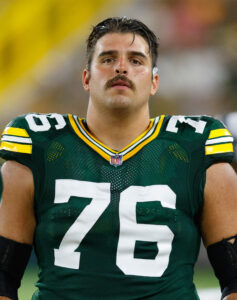 Having given Elgton Jenkins a top-market contract, the Packers predictably let Runyan walk. The latter will play his home games in the stadium where his father, a longtime Eagles right tackle, frequently tussled with Michael Strahan. One of five UFA guards to draw an eight-figure-per-year contract this offseason, Runyan brings three years of starter experience to New York. PFR’s No. 32 overall free agent, Runyan should be a big upgrade from recent Giants guard offerings.
Having given Elgton Jenkins a top-market contract, the Packers predictably let Runyan walk. The latter will play his home games in the stadium where his father, a longtime Eagles right tackle, frequently tussled with Michael Strahan. One of five UFA guards to draw an eight-figure-per-year contract this offseason, Runyan brings three years of starter experience to New York. PFR’s No. 32 overall free agent, Runyan should be a big upgrade from recent Giants guard offerings.
The $10MM-per-year blocker logged full seasons at both guard positions, shifting to RG to accommodate Jenkins’ move back inside during the 2022 season. A 50-game starter, the former sixth-round pick ranked 17th among interior O-linemen in pass block win rate last season. Pro Football Focus slotted Runyan 47th among guards.
This year marks a new position and foreign contractual territory for Eluemunor, who had played on three straight one-year deals (none eclipsing $3MM) with the Raiders. The low-cost starter parlayed his work at right tackle and right guard into a midlevel contract. Eluemunor, 29, started 31 games — mostly at RT — for the Raiders over the past two seasons. PFF rated the former Ravens fifth-rounder 36th among tackles in 2023.
The Giants’ decision to give Evan Neal another shot at right tackle will kick Eluemunor inside, where has not played regularly since 2021. Even in his 2021 Raiders debut, Eluemunor only logged 266 snaps at guard. He did not see any time there last season. PFF has rated Neal as a bottom-two tackle regular in each of the past two seasons, and he is coming off a midseason foot fracture — an injury initially misdiagnosed as a sprained ankle — that sidelined him throughout the Giants’ offseason program.
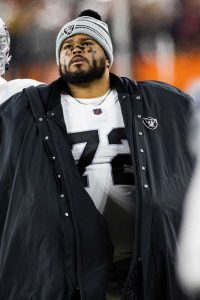 Eluemunor looms as an emergency fix for the Giants, who have some interior insurance in Stinnie — who started in Super Bowl LV and made 11 starts last season — and Schlottmann (14 career starts in Denver and Minnesota). The Giants have converted guard Joshua Ezeudu tentatively in place as their swing tackle, but the 2022 third-rounder allowed five sacks despite playing just 266 snaps in place of Andrew Thomas last season.
Eluemunor looms as an emergency fix for the Giants, who have some interior insurance in Stinnie — who started in Super Bowl LV and made 11 starts last season — and Schlottmann (14 career starts in Denver and Minnesota). The Giants have converted guard Joshua Ezeudu tentatively in place as their swing tackle, but the 2022 third-rounder allowed five sacks despite playing just 266 snaps in place of Andrew Thomas last season.
The offseason additions aside, Neal’s development remains paramount in New York, as the Schoen regime drafted him seventh overall. Neal continuing down this road would remind of Ereck Flowers‘ underwhelming (in New York, that is) career path.
Before the Giants came to terms with Lock, they were on the Jameis Winston radar. The latter ended up in Cleveland, helping lead Lock to the Big Apple. A run of rumors has emerged regarding Lock’s role, and while the ex-Broncos and Seahawks QB has not been a team’s preferred starter since Teddy Bridgewater‘s second 2021 concussion forced Vic Fangio to move Lock back into his lineup, the former second-round pick has been mentioned as a possible Jones competitor at multiple points this offseason.
Seahawks GM John Schneider said the prospect of a competition with Jones helped lure Lock away from Seattle, and NFL.com’s Daniel Jeremiah noted shortly after the draft the Missouri alum carries a legitimate shot at wresting the job from Jones. Lock has said he expects his role to be a Jones backup, and Daboll pushed back on the notion this will be a competition. Lock seeing starts may not remind of the ignominious Mike Glennon stretch, but if the Giants are starting the inconsistent ex-Broncos option without Jones having suffered an injury, the team’s big-picture plan will have veered well off course.
 Lock’s only full season as a starter (2020) featured him leading the NFL in INTs (15) despite only finishing 12 games. The Broncos traded for Bridgewater to demote the John Elway-era draftee and then included him in 2022’s blockbuster Russell Wilson trade. Despite Lock initially being viewed as more likely to succeed Wilson in Seattle, he lost a battle with Geno Smith and never threatened the eventual Comeback Player of the Year’s job security again.
Lock’s only full season as a starter (2020) featured him leading the NFL in INTs (15) despite only finishing 12 games. The Broncos traded for Bridgewater to demote the John Elway-era draftee and then included him in 2022’s blockbuster Russell Wilson trade. Despite Lock initially being viewed as more likely to succeed Wilson in Seattle, he lost a battle with Geno Smith and never threatened the eventual Comeback Player of the Year’s job security again.
Lock, 27, is a career 59.7% passer who holds a 6.7 yards-per-attempt figure. The Giants could look to park Jones late in the season — similar to the Raiders and Broncos’ actions with their starters over the past two years — in a bubble-wrap scenario that prevents $12MM in injury guarantees from entering the equation, but that would seemingly only come up if the team is well out of the playoff mix. Still, Lock represents an interesting wild card whose usage could be telling about the franchise’s immediate future.
Wilson’s short free agency tour stopped through New York, though this “what if” involving a Giants QB investment did not rival the one that came in April. Wilson, who ended up with the Steelers on a vet-minimum deal, would have likely held the upper hand on Jones in a competition. As of now, Lock is intriguing insurance.
Re-signings:
- Isaiah Simmons, LB. One year, $5MM ($1.43MM guaranteed)
- Casey Kreiter, LS. One year, $1.38MM ($1.15MM guaranteed)
- Isaiah Hodgins, WR. One year, $1MM ($325K guaranteed)
Notable losses:
- Saquon Barkley, RB
- Ben Bredeson, G
- Matt Breida, RB
- Gary Brightwell, RB (waived/injured)
- Cam Brown, LB
- Randy Bullock, K
- Parris Campbell, WR
- Jarrad Davis, LB
- Jacob Eason, QB
- Mark Glowinski,G (released)
- Sean Harlow, OL
- Adoree’ Jackson, CB
- Xavier McKinney, S
- Matt Peart, T
- Tyre Phillips, OL
- Justin Pugh, OL
- A’Shawn Robinson, DL
- Sterling Shepard, WR
- Jack Stoll, TE
- Tyrod Taylor, QB
- Darren Waller, TE (retired)
- Jihad Ward, DL
- Cade York, K
 In terms of accomplishments, Frank Gifford is the best running back in Giants history. Production-wise, it is Tiki Barber, who still sits in the top 30 on the NFL’s rushing yardage list. For sheer talent, it is difficult to beat Barkley, whom the Giants hoped would make a Canton case someday. If Barkley is to launch a Hall of Fame case, he will need to make significant contributions in Philadelphia.
In terms of accomplishments, Frank Gifford is the best running back in Giants history. Production-wise, it is Tiki Barber, who still sits in the top 30 on the NFL’s rushing yardage list. For sheer talent, it is difficult to beat Barkley, whom the Giants hoped would make a Canton case someday. If Barkley is to launch a Hall of Fame case, he will need to make significant contributions in Philadelphia.
The Giants closed a six-year Barkley partnership by determining they did not want to pay what it required — or even close to it — to employ the two-time Pro Bowler in 2024. That will mean, barring injury, two games against Barkley this season.
The team made it clear in 2023 Jones would be its priority and Barkley the secondary concern. Positional value supported this stance, despite Barkley being a far superior player. Barkley played the season on a $10.1MM franchise tag. Barkley suffered a high ankle sprain early in the season, but he exited 2023 a safer bet following Jones’ ACL tear. As the Giants launched a serious research effort to consider adding a Jones replacement, Barkley said they were not among the four teams to make an offer (though, Barkley and Schoen’s accounts may differ here, as a recent Hard Knocks trailer dangled). This led to a three-year, $37.75MM Eagles agreement.
